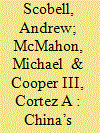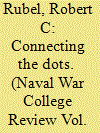|
|
|
Sort Order |
|
|
|
Items / Page
|
|
|
|
|
|
|
| Srl | Item |
| 1 |
ID:
146372


|
|
|
|
|
| Summary/Abstract |
One of the most eye-catching episodes in China’s defense buildup was the 25 September 2012 commissioning of Beijing’s first aircraft carrier. The sixtyfive-thousand-ton Liaoning was launched with much fanfare, presided over by the president of the People’s Republic of China (PRC), then Hu Jintao, as well as by the vice president and Hu’s political successor, Xi Jinping. The commissioning of Liaoning underscored both the remarkable advances in the PRC’s shipbuilding in recent decades and the significant limitations that remain. The vessel immediately became the largest in the People’s Liberation Army Navy (PLAN).
|
|
|
|
|
|
|
|
|
|
|
|
|
|
|
|
| 2 |
ID:
146371


|
|
|
|
|
| Summary/Abstract |
An announcement in 2013 by then–Secretary of Defense Chuck Hagel that the Navy might reduce its aircraft carrier fleet from eleven to eight was an indication not only of harsh budget realities but also of changed operational circumstances at sea. 1 In World War II, the aircraft carrier displaced the big-gun battleship as the capital ship. The United States subsequently used its fleet of aircraft carriers to exercise the command of the sea that it had won in the war to secure the peace.
|
|
|
|
|
|
|
|
|
|
|
|
|
|
|
|
| 3 |
ID:
146374


|
|
|
|
|
| Summary/Abstract |
The era of maritime discoveries was a period of expansive exploration, one that prompted the emergence of a range of maritime thinking in the sixteenth century, mainly in the countries of southern Europe. Of all the insightful and innovative works written at that time, as shown in table 1, Fernando Oliveira’s Art of War at Sea has two distinctive features. 1 First, it went beyond the usual operational and tactical perspectives and entered the domain of strategy. While Art of War at Sea is certainly a period piece, it is unusual in foreshadowing some aspects of late nineteenth- and early twentieth-century naval strategic thought in the works of Alfred Thayer Mahan.
|
|
|
|
|
|
|
|
|
|
|
|
|
|
|
|
| 4 |
ID:
146373


|
|
|
|
|
| Summary/Abstract |
The Naval War College’s China Maritime Studies Institute (CMSI) uses primary and secondary Chinese-language sources to produce original scholarly research that enables current and future leaders to understand better the complexities of contemporary China’s maritime rise. The below translation offers non–Chinese readers at least a sense of what can be gained by considering Chinese texts in the original. Zhang Wei’s article, originally published in the journal Frontiers (Xueshu Qianyan) in July 2012, is a historiographical survey of the critical Western and Chinese texts and thinkers who have shaped the concept of sea power in China. It gives insight into the richness of the Chinese discourse about sea power. Of particular note is the fact that as Chinese strategists engage in this discourse, they no longer question the utility of sea power; even the country’s most ardent land-power advocates recognize the strategic and economic importance of the sea. On the contrary, the primary question now concerns the form and character Chinese sea power should take. The CMSI hopes this translated article (in which the endnote citations are original) will inform and strengthen the debate in the West about this critical question.
|
|
|
|
|
|
|
|
|
|
|
|
|
|
|
|
| 5 |
ID:
146369


|
|
|
|
|
| Summary/Abstract |
The Israeli-Palestinian conflict is seemingly intractable. It involves contentious issues, such as extended occupation, the status of Jerusalem, a claimed “right of return” for Palestinian refugees, and recognition of a Palestinian state. Episodic hostilities have punctuated the conflict, causing heavy civilian casualties on both sides. The tactics employed have proved highly controversial, with some, such as terrorism and the direct targeting of the Israeli population, self-evidently qualifying as war crimes.
|
|
|
|
|
|
|
|
|
|
|
|
|
|
|
|
| 6 |
ID:
146370


|
|
|
|
|
| Summary/Abstract |
ACooperative Strategy for 21st Century Seapower: Forward, Engaged, Ready” (CS21R) appeared in March 2015.1 It aims to “refresh” the strategy with the same primary title that first appeared back in 2007 and that has to a significant extent guided U.S. maritime policy over the past eight years.2 Navies both reflect and help shape the international context. They matter. So, when the world’s most powerful navy looks at its strategy and decides on a change, the rest of the world should pay attention, since the change will reveal at least some of America’s strategic preoccupations and help set the agenda, for a few years at least, for diplomats and other navies around the world.
|
|
|
|
|
|
|
|
|
|
|
|
|
|
|
|
|
|
|
|
|